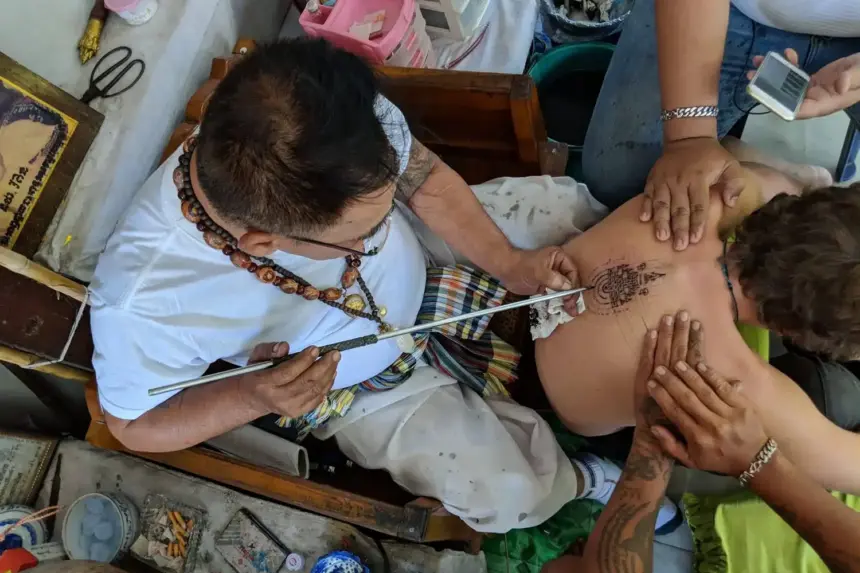Exploring the Sacred Art of Sak Yant Tattoos in Thailand
Introduction to Sak Yant Tattoos
Sak Yant tattoos are not just a form of body art but are deeply ingrained in the spiritual and cultural fabric of Thailand. Known also as “Yantra” tattoos, these intricate designs are believed to offer protection, bring good luck, and enhance the spiritual life of the wearer. The words “Sak” means “to tap” in Thai, referring to the tattooing method, and “Yant” comes from the Sanskrit word “yantra,” meaning mystical diagram or magic.
Historical Roots
The tradition of Sak Yant tattoos stretches back centuries, with origins that intertwine with various spiritual beliefs including Buddhism, Hinduism, and indigenous animism. The oldest known references date back to the Khmer Empire, which influenced much of Southeast Asian culture.
By the time of the Ayutthaya Kingdom in the 14th century, Sak Yant Tattoos were commonly used by warriors for protection in battle. These tattoos were traditionally given by Buddhist monks or spiritual masters known as “Ajarns” who have dedicated years to studying sacred texts and the art of tattooing.
The Art and Meaning Behind the Designs
Each Sak Yant tattoo carries profound meanings, often symbolizing different aspects of life:
- Hah Taew (Five Lines): One of the most recognized Sak Yant tattoos, famously sported by Angelina Jolie, symbolizes protection from evil spirits, increased good fortune, and invincibility. Each line represents a different blessing, such as avoiding harm, luck in business, and attraction.
- Gao Yord (Nine Peaks): This design represents the nine peaks of Mount Meru, a mythical mountain in Hindu and Buddhist cosmology, symbolizing strength, courage, and protection.
- Paed Tidt (Eight Directions): This tattoo is for those seeking protection in all directions of their life, ensuring safety from all angles of danger or misfortune.
- Animal Yants: Tigers, elephants, and mythical creatures like the Garuda are used for their symbolic strengths, such as power, wisdom, or good luck.
Each tattoo is accompanied by sacred mantras or kathas, which are chanted by the Ajarn to imbue the tattoo with its spiritual power.
The Process of Getting a Sak Yant
The experience of receiving a Sak Yant tattoo is ritualistic and deeply spiritual:
- Location: While many temples offer Sak Yant, Wat Bang Phra near Bangkok and various temples in Chiang Mai are among the most famous. However, not all temples accept foreigners, and some charge a donation, while others might have a fixed fee.
- Preparation: Before the tattooing begins, one must offer gifts to the monk or Ajarn, which usually include flowers, incense, and sometimes cash. Proper etiquette is crucial, including respectful attire and behavior.
- Tattooing Technique: Traditionally, Sak Yant tattoos are done by hand-poking or tapping the skin with a needle attached to a bamboo stick or steel rod, rather than using modern tattoo guns. This method is believed to add to the spiritual potency of the tattoo.
- Blessing: After the tattoo is completed, a blessing or prayer is given to activate the yant’s protective powers. The Ajarn will chant specific mantras that correspond with the design’s intended benefits.
Modern Adaptations and Controversies
- Tourism vs. Tradition: With the rise in tourism, Sak Yant tattoos have become a popular “must-do” for visitors, leading to a blend of authentic practices and more commercialized experiences. This has sparked debates about cultural appropriation and the dilution of sacred practices.
- Hygiene Concerns: Traditionally, Sak Yant tattoos might not meet modern hygiene standards, although many reputable Ajarns now use disposable needles and clean practices to cater to health-conscious tourists.
- Gender Restrictions: In some traditional settings, monks might not tattoo women due to Buddhist monastic rules, leading to the rise of Ajarns who have left the monkhood to provide tattoos to all genders.
Conclusion
Getting a Sak Yant tattoo in Thailand is more than just adding ink to your skin; it’s an immersion into a centuries-old tradition that blends art, religion, and spirituality.
Whether you’re seeking protection, fortune, or simply a unique travel experience, the journey to a Sak Yant can be one of the most memorable parts of your visit to Thailand. However, it’s important to approach this sacred art with respect, understanding, and an appreciation for its deep cultural significance.










